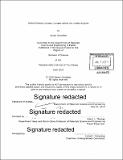| dc.contributor.advisor | Edwin L. Thomas. | en_US |
| dc.contributor.author | González, Xavier (Xavier R. González Barrios) | en_US |
| dc.contributor.other | Massachusetts Institute of Technology. Department of Materials Science and Engineering. | en_US |
| dc.date.accessioned | 2017-12-05T19:15:26Z | |
| dc.date.available | 2017-12-05T19:15:26Z | |
| dc.date.copyright | 2010 | en_US |
| dc.date.issued | 2010 | en_US |
| dc.identifier.uri | http://hdl.handle.net/1721.1/112496 | |
| dc.description | Thesis: S.B., Massachusetts Institute of Technology, Department of Materials Science and Engineering, 2010. | en_US |
| dc.description | Cataloged from PDF version of thesis. | en_US |
| dc.description | Includes bibliographical references (pages 50-52). | en_US |
| dc.description.abstract | An experimental study was performed to design and fabricate an edible photonic crystal made of alternating layers of food grade titanium dioxide and agar that is able to selectively reflect wavelengths of light within the visible spectrum and allow for dynamic color changes through the tuning mechanism of swelling its agar layers with the addition of edible solvents. After doing a literature search to discover which materials were available to create this edible photonic structure, a trial and error process was conducted using deposition and film thickness characterization techniques to optimize the physical and optical characteristics of the layers composing the photonic structure. The materials selected for the layers in the structure yield a high refractive index contrast, which allows for high reflectivity with a reduced amount of total layers. The multilayer stack can be designed to reflect particular wavelengths by selecting the thickness of the layers accordingly. Thin film characterization took place through the use of profilometry, ellipsometry, and atomic force microscopy. The feasibility and practicality of two manufacturing techniques, spin-coating and RF-sputtering, were analyzed in the process of learning how to assemble an edible multilayer stack for molecular gastronomy applications. | en_US |
| dc.description.statementofresponsibility | by Xavier González/ | en_US |
| dc.format.extent | 54 pages | en_US |
| dc.language.iso | eng | en_US |
| dc.publisher | Massachusetts Institute of Technology | en_US |
| dc.rights | MIT theses are protected by copyright. They may be viewed, downloaded, or printed from this source but further reproduction or distribution in any format is prohibited without written permission. | en_US |
| dc.rights.uri | http://dspace.mit.edu/handle/1721.1/7582 | en_US |
| dc.subject | Materials Science and Engineering. | en_US |
| dc.title | Edible photonic crystals tunable within the visible regime | en_US |
| dc.type | Thesis | en_US |
| dc.description.degree | S.B. | en_US |
| dc.contributor.department | Massachusetts Institute of Technology. Department of Materials Science and Engineering | |
| dc.identifier.oclc | 1011512909 | en_US |
